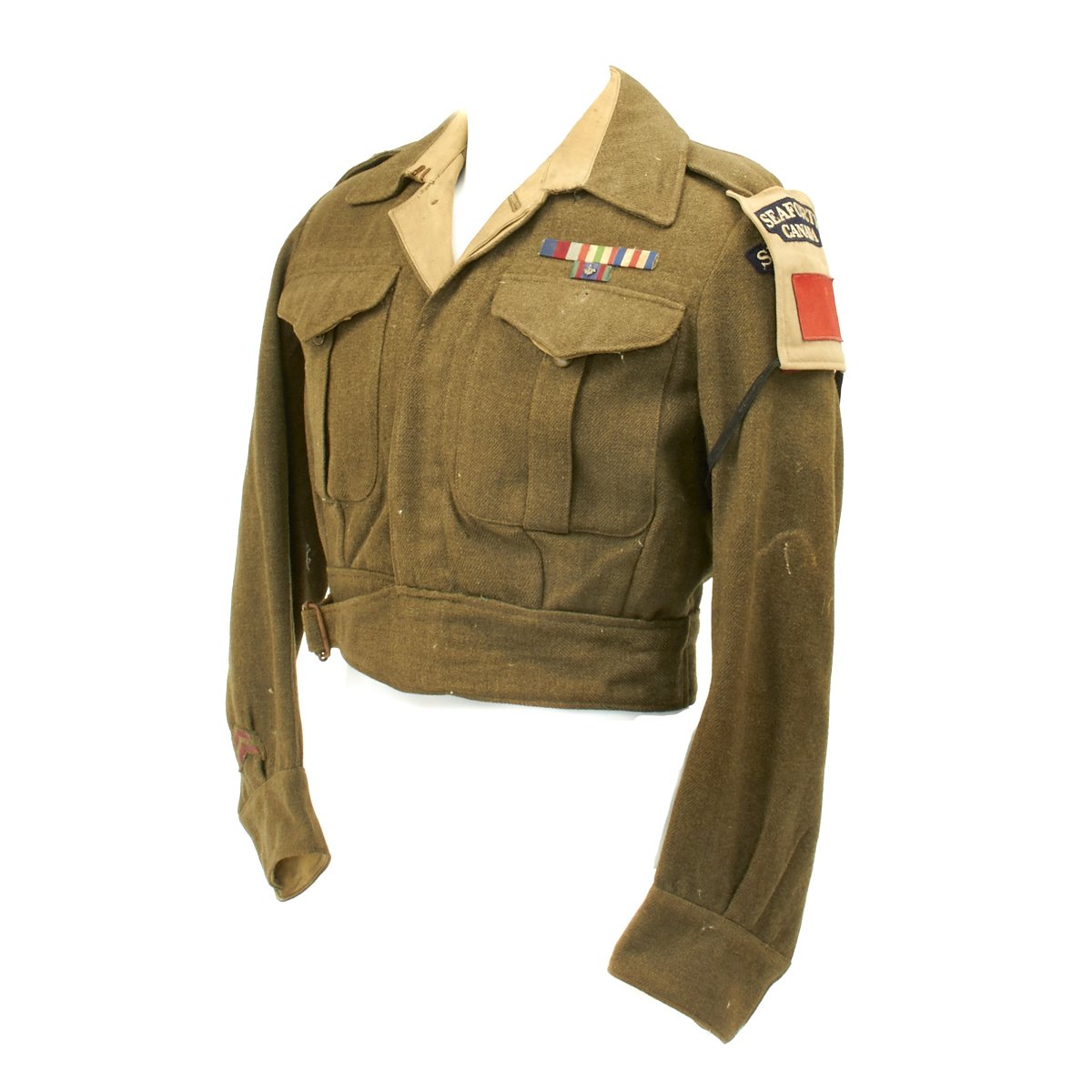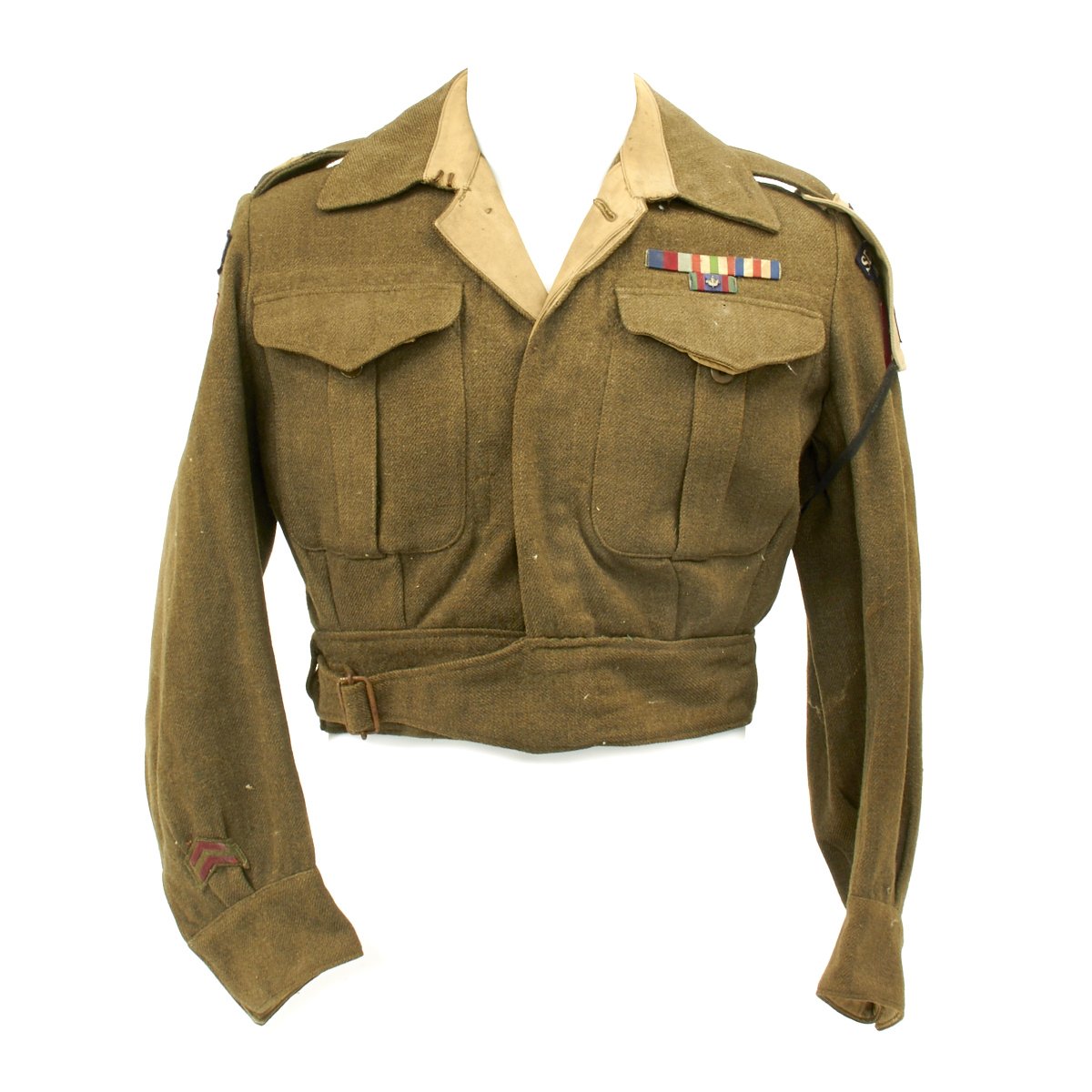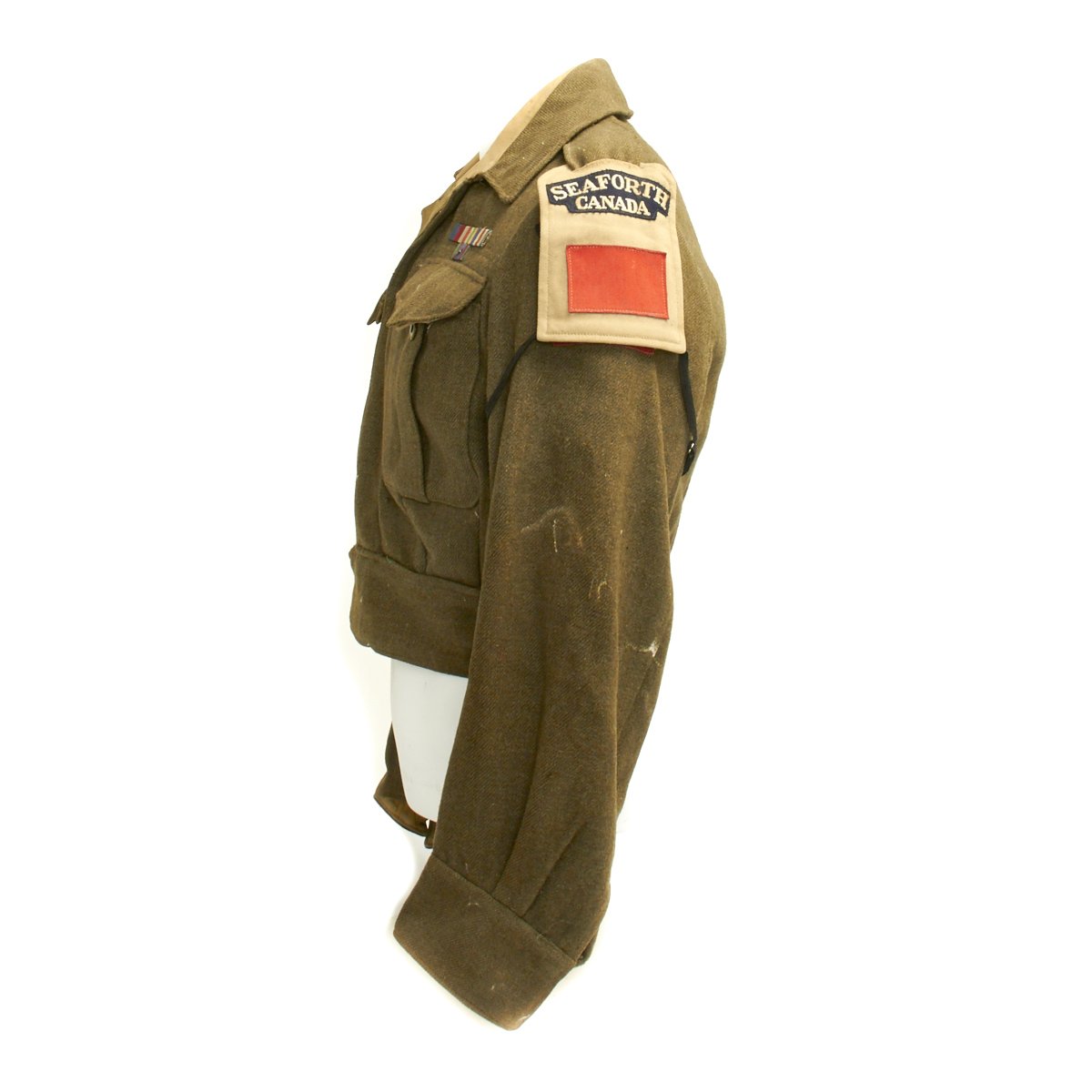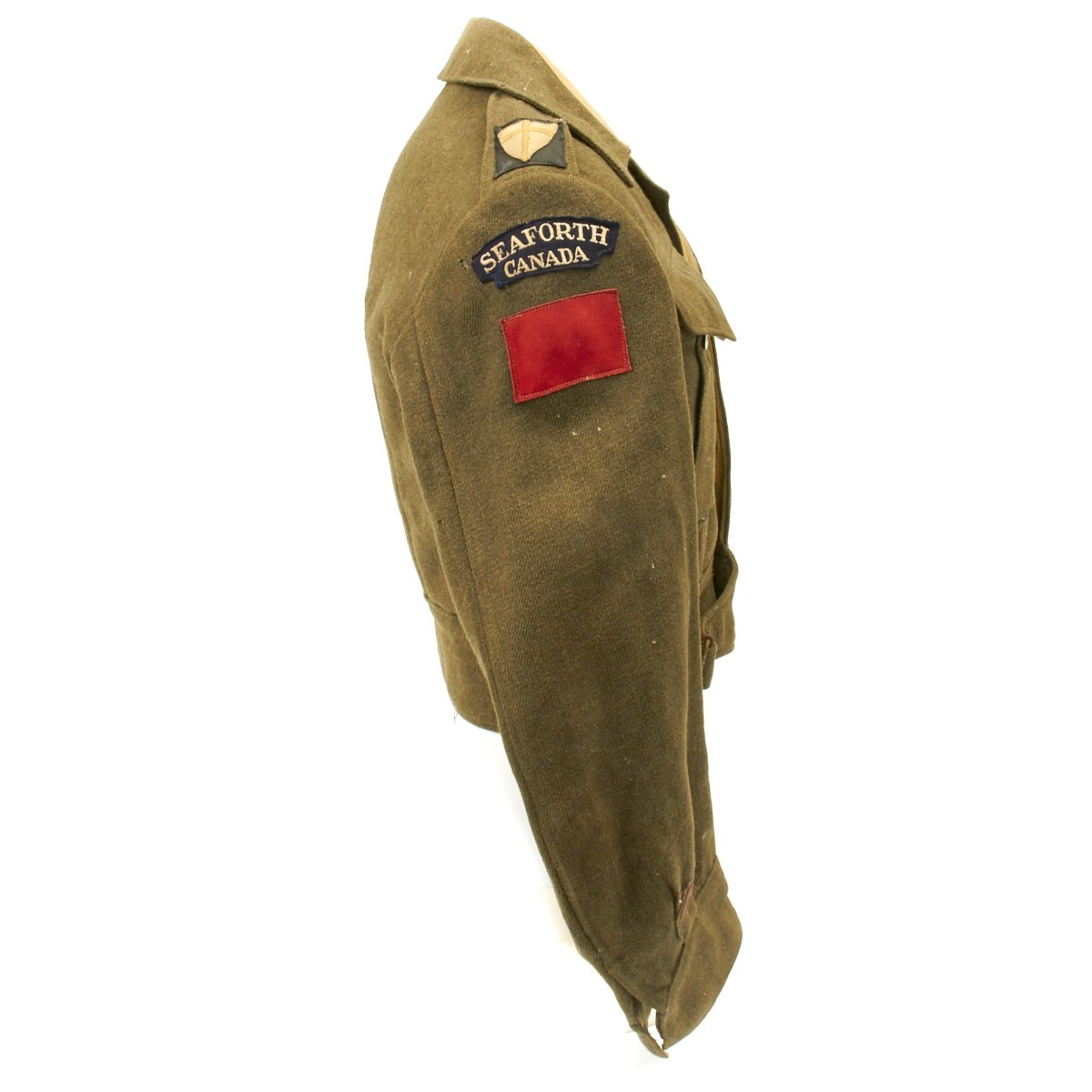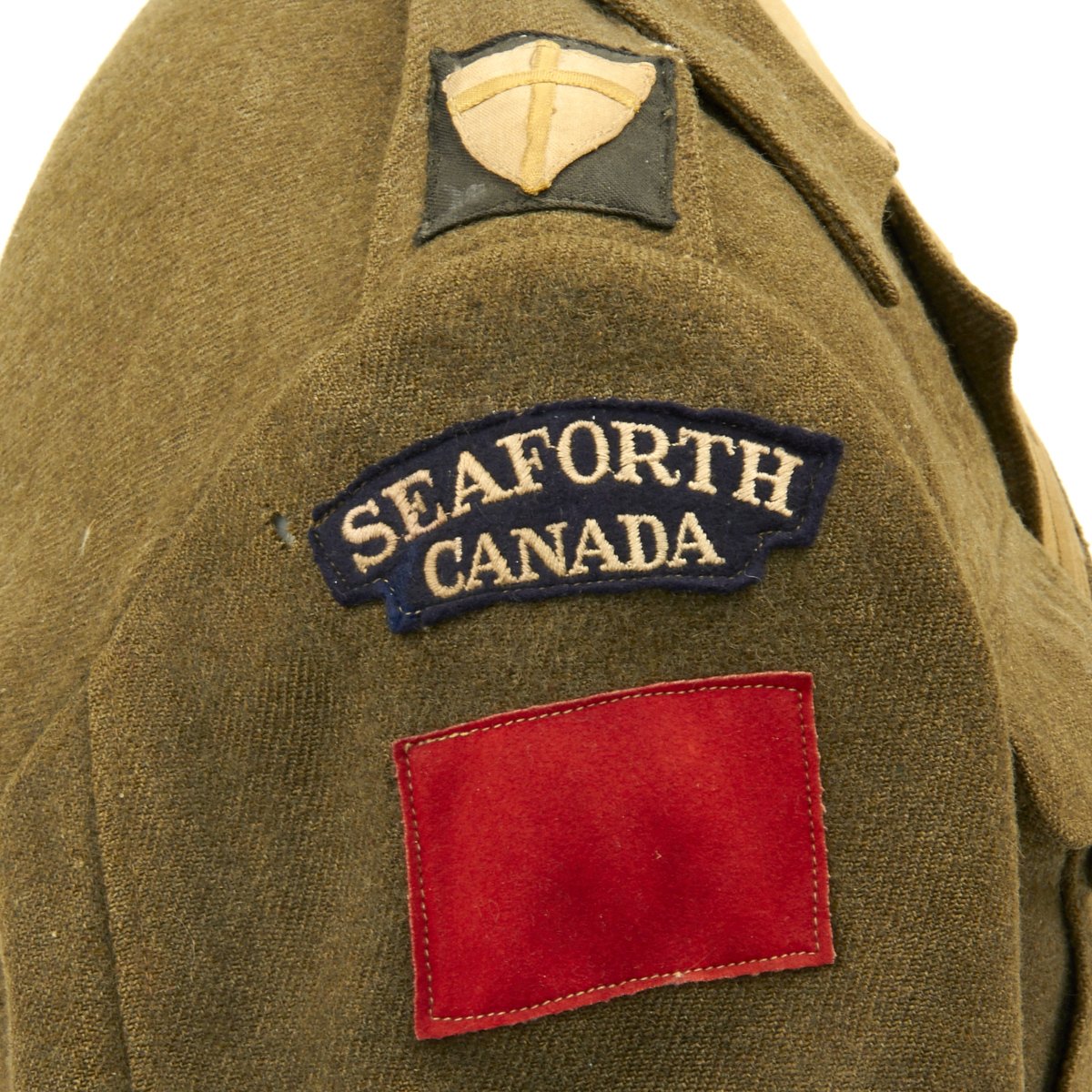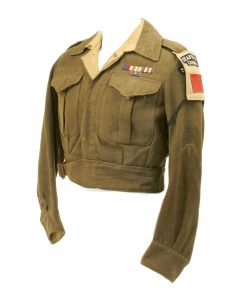Original Canadian WWII Seaforth Highlanders Battle Dress Tunic Original Items
$ 495,00 $ 148,50
Original Item: Only One Available. This is a fine khaki wool tunic with a five metal dish button fly front closure, and a lay-down collar. There are pleated patch pockets to each breast, whose scalloped flaps have button closures. Above the left breast pocket is a double ribbon bar. The lower is the Volunteer Medal with a maple leaf.The upper bar consists of 1939-1945 Star, Italy Star, and the France and Germany Star.
The integral shoulder straps are buttoned near the neck. The outside seam slashes at the pleated cuffs also have single, hidden button closures. All of the metal dish buttons retain all of their original olive drab paint, and all appear to have their original stitching. Three stitched eyelet ventilation holes are beneath each armpit. An integral belt, with a nickel-silver buckle and vertical wool retaining loop on its opposite side, is to the waistband. The back has multiple pleats to it above the waistband.
The interior collar, waistband, and along either side of the front closure is lined in tan-colored cotton, and a large, vertical slash pocket, in the same material as the lining, is to each interior breast. Three vertical button holes are to a horizontal fly along the interior rear waistband, which allowed the tunic to be buttoned to the matching trousers.
Below each shoulder strap are SEAFORTH CANADA canvas and red shoulder flashes. Sewn above the right cuff are two red chevrons representing two years service.
History of the Seaforths in WWII:
In the spring of 1939 it looked as if Canada would soon be at war again. Unlike the First World War this time The Seaforth Highlanders of Canada were among the first to deploy. On September 1, 1939, nine days before the Canadian declaration of war, the Seaforths were ordered to mobilize. In just one week the regiment recruited up to its full war-time strength and filled its first line of reinforcements. By Christmas 1939 they were aboard the UK troopship RMS Andes crossing the Atlantic to Scotland.
After the withdrawal from Dunkirk the Seaforths were one of the few fully equipped regiments in England. During the Battle of Britain they filled a variety of roles including manning anti-air batteries, providing anti-parachute defence and frontline coastal defence. In August 1942 Canada’s 2nd Division invaded Dieppe. It was for his actions during this raid that former Seaforth officer Lieutenant Colonel Charles Merritt was awarded his Victoria Cross while commanding The South Saskatchewan Regiment. He was presumed dead but it was discovered later that he was in fact taken prisoner.
The Seaforths however as part of the 1st Canadian Infantry Division would not see combat until July 1943 in Operation Husky, the invasion of Sicily. The beach landing was relatively uneventful but the Seaforths would soon see hard battles as they fought veteran German units for hilltop town after hilltop town through Valguarnera, Leonforte, Nissoria, Agira and Regalbuto, to Adrano.
When the Seaforths crossed into Italy on 4 September 1943 they found themselves and the rest of 1st Division pursuing the Germans north. The Germans had decided not to defend the south of Italy but to fight only occasionally, buying time for them to build up their defences further north. By 25 October the Seaforths had fought their way over 300 miles from the landings in Reggio Calabria to the town of Baranello.
After a rest in Baranello the Seaforths were back into action. They had reached the Gustav Line, where the Germans planned to make their first stand. From December 6 to 22 the 1st Division advanced only three miles from the Moro River to the edge of a small town named Ortona. The town was located on the eastern end of the Gustav Line on the Adriatic Sea. The narrow streets and dense buildings lead to intense street to street fighting. The battle was so intense that it was nicknamed “little Stalingrad”.
Amidst the fighting on the night of 25 December the Seaforth’s quartermaster arranged a Christmas dinner for the soldiers at the front. One at a time the four companies of the regiment were rotated off the line to the Church of Santa Maria di Constantinopoli. As they sat down to a fresh meal of roast pork and mashed potatoes one soldier, a corporal, played the church’s organ over the roar of the battle just a few hundred yards to the north. A few days later on 28 December the Germans pulled out of Ortona during the night, leaving the town to the Allies. Every year the Seaforth Highlanders of Canada commemorate this battle with the Ortona Dinner. This commemorative dinner takes the place of the regiment’s annual Christmas dinner. Veterans from the battle along with the unit’s serving and former members sit down to a Christmas dinner with the same menu served in the church in 1943.
From Ortona the Seaforths continued to move north fighting through the Liri Valley and breaking through the AH Line, the Germans’ second defensive line. This was the hardest fought battle for the Seaforths of the entire Italian campaign. At one point on the afternoon of 23 May 1944, the Seaforths, having taken the line, repelled a German counterattack, and when the Germans pulled off only eight soldiers remained, commanded by C Company Sergeant Major J.M. Duddle, who was the senior man left on the line. By the end of the day the Seaforths had taken 210 casualties including 52 killed.
The regiment continued fighting in Italy through Gothic Line, across the Savio River, where Private E.A. “Smokey” Smith’s actions earned him a Victoria Cross and through the Po Valley. On 13 March 1945 the Seaforths boarded ships to begin the trip to Northwest Europe where they were to be used in the liberation of The Netherlands.
The Seaforths travelled through Germany and entered The Netherlands on April 7 through the town of ‘s-Heerenberg. Their first action was the crossing of the IJssel River on 11 April. They then chased the Germans west across the fields south of Apeldoorn until the surrender of the Germans on 8 May 1945. On the 8th the Seaforths were ordered to Amsterdam to take possession from the German occupiers and make arrangements for the Germans to march home. The Seaforths were the first allied regiment to enter the city and the city lined the streets to welcome their liberators. The war was over. On 7 October 1945 the Seaforth Highlanders arrived home in Vancouver. An estimated 100,000 people lined the street from the Canadian Pacific Railway station to the Seaforth Armoury where the overseas battalion was dismissed for the last time.
Fast Shipping with Professional Packaging
Thanks to our longstanding association with UPS FedEx DHL, and other major international carriers, we are able to provide a range of shipping options. Our warehouse staff is expertly trained and will wrap your products according to our exact and precise specifications. Prior to shipping, your goods will be thoroughly examined and securely secured. We ship to thousands clients each day across multiple countries. This shows how we're dedicated to be the largest retailer on the internet. Warehouses and distribution centres can be located throughout Europe as well as the USA.
Note: Orders with more than one item will be assigned a processing date depending on the item.
Before shipping before shipping, we'll conduct a thorough inspection of the items you have ordered. Today, the majority of orders will be delivered within 48 hours. The delivery time will be between 3-7 days.
Returns
The stock is dynamic and we cannot completely manage it because multiple stakeholders are involved, including our factory and warehouse. So the actual stock may alter at any time. It's possible that you may not receive your order once the order has been made.
Our policy is valid for a period of 30 days. If you don't receive the product within 30 days, we are not able to issue a refund or an exchange.
You can only return an item if it is unused and in the same state as the day you received it. You must have the item in its original packaging.
Related products
Uncategorized
Uncategorized
Uncategorized
Uncategorized
Uncategorized
Uncategorized
Uncategorized
Armoured Fighting Vehicles of the World: AFVs of World War One (Hardcover Book) New Made Items
Uncategorized
Uncategorized
Uncategorized
Uncategorized
Australian WWII Owen MK1 Machine Carbine SMG Custom Fabricated Replica with Sling Original Items
Uncategorized
Uncategorized
Uncategorized
Uncategorized
Uncategorized
Uncategorized
Uncategorized
Uncategorized
